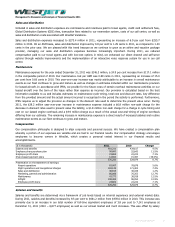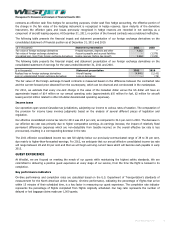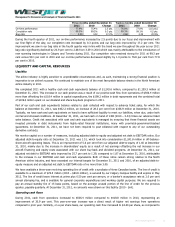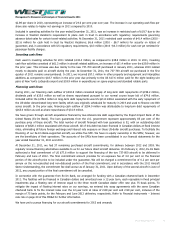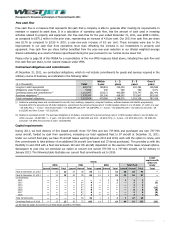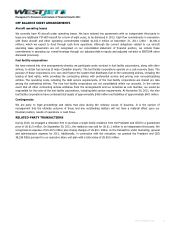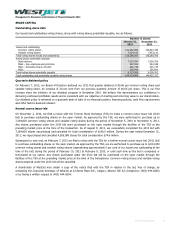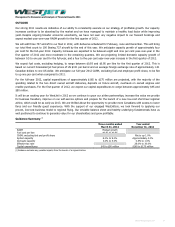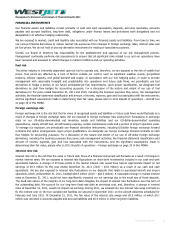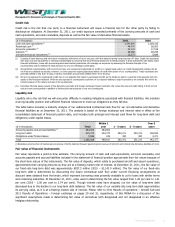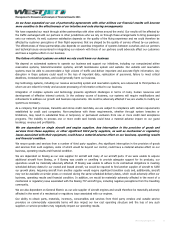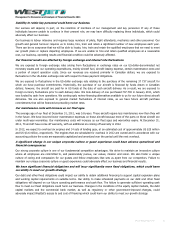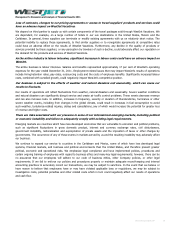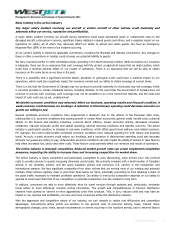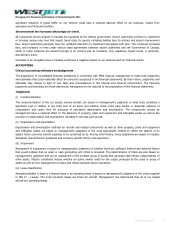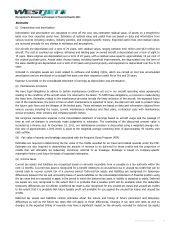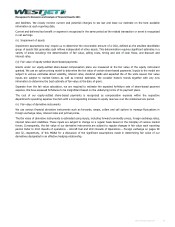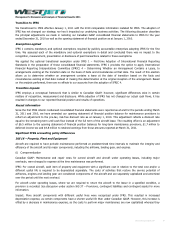Westjet 2011 Annual Report Download - page 41
Download and view the complete annual report
Please find page 41 of the 2011 Westjet annual report below. You can navigate through the pages in the report by either clicking on the pages listed below, or by using the keyword search tool below to find specific information within the annual report.
Management’s Discussion and Analysis of Financial Results 2011
│
Credit risk
Credit risk is the risk that one party to a financial instrument will cause a financial loss for the other party by failing to
discharge an obligation. At December 31, 2011, our credit exposure consisted primarily of the carrying amounts of cash and
cash equivalents, accounts receivable, deposits as well as the fair value of derivative financial assets.
($ in thousands) 2011 2010
Cash and cash equivalents (i) 1,243,605 1,159,316
Restricted cash (i) 48,341 28,583
Accounts receivable (ii) 34,122 17,518
Deposits (iii) 28,386 28,258
Derivative financial instruments (iv)
12,273 5,689
(i) Consists of bank balances and short-term investments with terms of up to one year, with the majority having terms less than 97 days. Credit risk associated
with cash and cash equivalents is minimized substantially by ensuring that these financial assets are invested primarily in debt instruments with highly rated
financial institutions, some with provincial-government-backed guarantees. We manage our exposure by assessing the financial strength of our
counterparties and by limiting the total exposure to any one individual counterparty.
(ii) All significant counterparties, both current and new, are reviewed and approved for credit on a regular basis under our credit management policies. We do
not hold any collateral as security; however, in some cases we require guaranteed letters of credit with certain of our counterparties. Trade receivables are
generally settled in less than 30 days. Industry receivables are generally settled within 30 to 60 days.
(iii) We are not exposed to counterparty credit risk on our deposits that relate to purchased aircraft, as the funds are held in a security trust separate from the
assets of the financial institution. While we are exposed to counterparty credit risk on our deposit relating to airport operations, we consider this risk to be
remote because of the nature and size of the counterparty.
(iv) Derivative financial assets consist of fuel derivative contracts and foreign exchange forward contracts. We review the size and credit rating of both current
and any new counterparties in addition to limiting the total exposure to any one counterparty.
Liquidity risk
Liquidity risk is the risk that we will encounter difficulty in meeting obligations associated with financial liabilities. We maintain
a strong liquidity position and sufficient financial resources to meet our obligations as they fall due.
The table below presents a maturity analysis of our undiscounted contractual cash flow for our non-derivative and derivative
financial liabilities as at December 31, 2011. The analysis is based on foreign exchange and interest rates in effect at the
consolidated statement of financial position date, and includes both principal and interest cash flows for long-term debt and
obligations under capital leases.
($ in thousands) Total Within 1
year 1 - 3 years 3 - 5 years Over 5
years
Accounts payable and accrued liabilities (i) 284,902 284,902 − − −
Long-term debt 975,770 204,770 382,271 250,723 138,006
Obligations under finance leases 5,596 245 490 490 4,371
Total 1,266,268 489,917 382,761 251,213 142,377
(i) Excludes current portion of maintenance provisions of $245, deferred frequent guest program revenue of $22,020 and interest rate derivative liabilities of $112.
Fair value of financial instruments
Fair value represents a point-in-time estimate. The carrying amount of cash and cash equivalents, accounts receivable, and
accounts payable and accrued liabilities included in the statement of financial position approximate their fair values because of
the short-term nature of the instruments. The fair value of deposits, which relate to purchased aircraft and airport operations,
approximates their carrying amounts as they are at a floating market rate of interest. At December 31, 2011, the fair value of
our fixed-rate long-term debt was approximately $937.3 million (2010 – $1,142.0 million). The fair value of our fixed-rate
long-term debt is determined by discounting the future contractual cash flow under current financing arrangements at
discount rates obtained from the lender, which represent borrowing rates presently available to us for loans with similar terms
and remaining maturities. At December 31, 2011, rates used in determining the fair value ranged from 1.28 per cent to 1.61
per cent (2010 – 2.00 per cent to 2.74 per cent). Though interest rates have dropped, our fair value of long-term debt
decreased due to the decline in our long-term debt balances. The fair value of our variable-rate long-term debt approximates
its carrying value, as it is at a floating market rate of interest. Please refer to 2011 Results of operations – Aircraft fuel and
2011 Results of Operations – Foreign exchange on pages 29 and 32, respectively, of this MD&A for a discussion of the
significant assumptions made in determining fair value of derivatives both designated and not designated in an effective
hedging relationship.
WestJet Annual Report 2011 41


